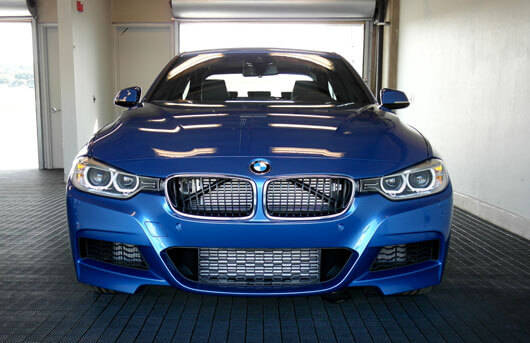
If the sport-sedan category were high school, the BMW 3 Series would be the captain of the football team, and maybe the debate squad … and the chess club. It’s popular (typically selling 90,000-100,000 units annually in the U.S.), and everyone wants to be like it (Cadillac is only the most recent example, boldly pitting its upcoming ATS sedan against the 3 Series in advertisements). And so it has always been.
A classed-up, roomier interior, more power and substantially improved gas mileage breathe new life into the redesigned 2012 BMW 3 Series sedan, which should continue to dominate the sport-sedan market.
Only the 3 Series’ sedan version has been redone, entering its sixth generation in 328i and 335i guise. The coupe, convertible and ultimate-performance M3 will continue for two more model years in their current form. The previous-generation wagon is being sold as a 2012, and a redesign will come within the next year.
On sale now, the 2012 sedans come only with rear-wheel drive. Fall 2012 will see the addition of all-wheel-drive versions, with the “xi” suffix, along with the first-ever hybrid 3 Series, the ActiveHybrid3 sedan. The 335d clean-diesel variant is now out of production, but it will likely return once BMW develops a new four-cylinder diesel engine.
As of the sedan’s launch, the 328i and 335i both come in a base trim level plus three “lines” — Modern, Luxury and Sport. Each is an option package with its own interior theme and exterior cosmetic tweaks. The Sport line adds a few performance-oriented changes, as well. I tested all these versions.
Autumn will bring a new trim level, called M Sport, with a more aggressive exterior and sport-themed interior touches. BMW is mum on the details, but M Sport packages typically include some performance enhancements, such as a sportier suspension.
Exterior & Styling
BMW has closed the book on an awkward design era helmed by American-born chief designer Chris Bangle. The outgoing 3 Series is arguably the one BMW car that escaped more than a glancing blow from the Bangle ugly stick. Regardless, I still think the 2012 sedan improves on it, though plenty of observers deemed it too plain. The way the headlight assemblies flow into the more three-dimensional grilles gives the car a broad look that belies a slight decrease in width compared with the 2011. The car is almost 4 inches longer. The light clusters themselves improve on other recent BMW redesigns: Rather than a translucent-white eyelash that looks like it was meant to be removed after shipping, each of the new car’s headlights has a more pleasing silver stripe with LED accents.
The trim level determines the number and finish of the grille slats, with gloss black designating Sport, and chrome trim demarcating Luxury. Modern splits the difference with a brushed-aluminum look. The trim on the lower air intakes also varies among the three. The M Sport trim level will bring a more aggressive front end with larger grille openings, M-badged wheels and flared rocker panels.
Drivetrain Revolution
The biggest news for the 2012 sedan is its improved drivetrains, including the 328i model’s new engine, whose power and efficiency is better than that of the 2011 328i. That’s despite it having a four-cylinder engine in place of an inline-six-cylinder — something BMW hasn’t sold here since 1999’s 318i. What’s different about this engine? Direct injection, variable valve timing and a twin-scroll turbocharger — technologies that BMW groups together and calls “TwinPower Turbo.”
Equipped with either a six-speed manual or a new eight-speed automatic transmission, the 328i takes off with authority. You’d never know you were driving a four-cylinder, and definitely not a turbo four. The torque is almost immediate. Though the power rating has increased only 10 horsepower over the 2011 sedan, to 240 hp, torque is up 60 pounds-feet, to 260, and it comes at 1,250 rpm, down from 2,750 rpm. (See the two model years compared.)
Sure enough, when I drove an automatic 328i on the highway, even when climbing moderate inclines the tachometer needle hovered below 1,500 rpm. Brilliant. This explains the automatic’s EPA-estimated 24/36 mpg city/highway, a giant leap from 2011’s 18/28 mpg with either transmission. Because it has six gears, the manual nets the 2012 sedan a lower rating: 23/34 mpg. There’s one upside to the stick: a slightly faster zero-to-60 mph time, according to BMW. It hits 60 in 5.7 seconds, and the automatic takes 5.9 seconds. It’s no longer a given that a manual is quicker, and while the BMW eight-speed shifts quickly, it’s not the type of dual-clutch transmission that always shifts faster than a human could. And because the manual has taller gears, you can hit 60 mph after just one gear change.
Bear in mind that we’re talking about the 328i here, not the more powerful 335i, whose drivetrain is unchanged versus 2011 but for the eight-speed automatic replacing the earlier six-speed. Its turbocharged, 3.0-liter inline-six engine produces 300 hp and 300 pounds-feet of torque. You feel and hear the difference with the six-cylinder’s greater urgency and pleasing exhaust note. (The 328i sounds respectable when accelerating, but at idle it has a faint diesel sound. While direct-injection engines perform well, their mechanical sound is often raucous.) BMW rates the 335i’s zero-to-60 time at 5.4 seconds.
Class-Leading Mileage
The 328i’s estimated combined city/highway mileage is 28 mpg, or 27 with the manual, compared with 22 mpg for either transmission in 2011. For comparison, the most efficient versions of the Audi A4 and Mercedes-Benz C-Class are rated 25 mpg, despite their lesser power. The 335i also gets a bump for 2012, from 19/28 to 20/30 mpg with the manual and from 19/28 to 23/33 mpg with the automatic. With a combined 26 mpg, the automatic 335i beats the comparable Mercedes C350’s 23 mpg and Infiniti G37’s 22 mpg.
Sometimes dramatic mileage improvements come with tradeoffs, but the 3 Series’ are few. As I detailed in my 5 Series review, BMW’s Efficient Dynamics provisions include regenerative braking, whereby the car’s alternator charges its battery when coasting and braking but decouples from the engine when accelerating. In the 5 Series, overly aggressive regeneration with the automatic transmission resulted in nonlinear braking unbefitting the “ultimate driving machine.” Blessedly, this doesn’t seem to be the case with the 2012 3 Series.
As noted, the car is quicker than ever. The eight-speed shifts quickly and smoothly, and it doesn’t hesitate too long before kicking down to pass, especially when in the Driving Dynamics Control’s selectable Comfort or Sport modes, which also vary the accelerator and power steering responsiveness. A new Eco Pro mode makes the accelerator resistant to accelerating (unless you floor it) and the transmission quick to upshift to more efficient gears. It also puts at the bottom of the tachometer a simple gauge to help you drive conservatively. The 3 Series’ product manager said he achieved 41 mpg on the highway in this mode by “hypermiling,” a strategy known alternately as “clogging traffic” and “driving like a pansy.”
It looks like we’re moving past the era when low-rolling-resistance tires could be called traction resistant. Despite having the word “efficient” in their name, the Goodyear EfficientGrip 18-inch summer tires delivered on the “grip” aspect as well. (Continental ContiSport Contact and Pirelli Cinturato tires were also fitted to test cars; multiple brands are supplying original-equipment rubber.) That’s one more step forward for efficiency without the usual step back.
Minor Mileage Tradeoff
The one failure among the mileage provisions is the standard auto start-top feature that shuts the engine off at a complete stop and restarts it when you take your foot off the brake (automatic transmission) or depress the clutch (manual). The best thing I can say about auto stop-start is that it couldn’t be simpler to turn off: The defeat button is adjacent to the engine-start button. You’ll probably make good use of it, because the engines restart awkwardly. The 335i is smoother than the 328i, but neither compares to the smoothness we’ve come to expect from hybrids. Even Porsche’s conspicuous start-stop feature is better than this. Where those sound and feel comparatively seamless, the 3 Series sounds and feels like an engine being started, and does so with more vibration than when you push the starter button after getting in the car.
As I say frequently these days, and consistently about updated BMW models, you don’t need the engine upgrade. The 328i will probably further diminish the 335’s share of sales — roughly 30 percent at the end of the 2011 model year. However, the difference between the two is clear: The 335i is substantially more exciting. If you have any intention of driving your 3 Series on a racetrack, this is the better one. On California’s Laguna Seca, I consistently found myself braking too late in the 328i, trying desperately to hold onto the speed I’d worked to build. The 335i had the extra guts needed to achieve appropriate speeds.
Softer, But Still BMW
Like many recent BMW redesigns, the 3 Series has been softened. The regular suspension in the base, Modern and Luxury lines isolates road imperfections better than the previous generation did, but it also allows more body motions, including a surprising degree of body roll — something that’s no longer an unavoidable tradeoff. Regardless, the car retains its legendary front/rear balance after mild understeer going into corners.
The redesign replaces conventional hydraulic power steering with electric power assist. Of its type, it’s well-executed. I wouldn’t say it’s quite as good as the old standard in terms of feedback, but the assist level isn’t erratic with speed changes, as some electric systems are. Speaking of erratic, the controversial active-steering option has been discontinued, replaced by a more straightforward variable-ratio steering option that gives more steering angle from less turn of the wheel.
The Sport line sits 10 mm lower on a firmer suspension arrangement. This is also the only version eligible for an adaptive suspension, a $900 option, which I drove. It feels more like the earlier generation, with better body control and livable ride quality. The Sport setting is notably firmer than Comfort, but not as punishing as early examples of this technology.
To be frank, for a car BMW claims is purchased primarily for its athletic driving experience, all 3 Series versions could get away with the Sport line’s firmer ride.
In the Cabin
Speaking of getting away with things, how do cars like the 3 Series and Mercedes-Benz C-Class get away with imitation-leather seats in their base trim levels? It’s convincing vinyl, but still. Imitation-metal trim also blows the base 3’s cover, but the finishes are otherwise high-quality. Soft-touch surfaces extend all the way down to the lowest door panels.
All three trim lines dial up the quality with leather upholstery, though in the 328i, power adjustments come bundled with other features in a separate $3,600 option package. Power seats are standard in the 335i. The Sport line has sport front seats with more prominent side bolsters. The aluminum trim in the Sport Line is patterned and textured — something I’d expect from Audi, and that’s a good thing. The Modern line I tested had beige gauge faces to match the color palette, and “open-pored” wood trim, which has raised grain as if it’s been rubbed down, creating what looks like sand drifts. I like the idea because it’s so unique, but it doesn’t look like real wood. Perhaps a light stain would be a better approach.
The front seats have nice, long travel for plenty of legroom. The 2012’s added overall length and wheelbase go right to backseat legroom, which was badly needed. Legroom still comes at the mercy of front-seat occupants, but I won’t penalize BMW for having generous front seat travel. The floor is high enough to raise your knees more than I appreciate, but short trips — and shorter passengers — should be fine.
Ergonomic Hits & Misses
The design and layout are characteristically simple but more stylish than the previous generation. There are ergonomic hits and misses. The big hit: After a history of half-assed spring-loaded cupholders, BMW has finally given in and incorporated two functional wells in the center console close to the dashboard. As if embarrassed by this sop to American thirst, BMW supplies a removable cover that hides them and doubles as a tray for “oddments.”
The Driving Dynamics Control buttons are now a rocker switch in the style of other recent BMW redesigns. It allows you to cycle through the various modes without pushing a bunch of separate buttons. The iDrive multifunction controller is now standard with a 6.5-inch display, and, similar to the cupholders, BMW has finally gotten it right. (The navigation option adds an 8.8-inch screen.) Though it’s not my favorite, the manual shifter improves on the previous generation’s. It feels more connected.
Unfortunately, the new 3’s automatic transmission still has the springy toggle-style gear selector, and the turn-signal stalk similarly springs back to center rather than staying in position until the turn is complete. If there’s a benefit to this design, it isn’t the driver’s.
The trunk is now a respectable 13.7 cubic feet, up from 12 in the previous generation. Less respectable is having to pay extra for a folding backseat — another infraction for which BMW and Mercedes are never prosecuted. In the upcoming ActiveHybrid3, the optional folding backseat is completely unobstructed, making it one of the only hybrid sedans to accomplish this goal.
Connectivity
By today’s standards, the 3 Series’ connectivity and iPhone integration is extensive, and includes standard BMW Assist, similar to GM’s OnStar. In a car with the BMW Apps option, an iPhone with the free BMW Connected app allows many features to be controlled by iDrive: Web Radio, Pandora and MOG internet radio, a calendar, Twitter, Facebook and Last Mile. No other Smartphones are currently supported.
Safety
As of its introduction, the 2012 3 Series hadn’t been crash-tested. Standard safety equipment includes frontal airbags and side curtains that protect front and rear occupants in side impacts. The front seats also have side-impact airbags and active head restraints. As is required of all 2012 and later models, the 3 Series includes antilock brakes and an electronic stability system with traction control.
3 Series in the Market
Though the 2012 3 Series has been softened a bit, it remains a leader in drivability and, now, in mileage, with no accompanying compromise. Combine this with its strong reputation and a brand cachet that companies like Audi, Cadillac and Infiniti haven’t achieved, and it seems untouchable. The 3 Series sells almost as many units annually as the Audi A4 and Mercedes C-Class combined, and I see no reason to expect a change.































